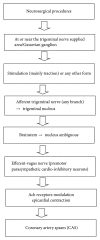Coronary spasm in neurosurgical patients and role of trigeminocardiac reflex
- PMID: 24587903
- PMCID: PMC3922006
- DOI: 10.1155/2014/974930
Coronary spasm in neurosurgical patients and role of trigeminocardiac reflex
Abstract
Background. Coronary artery spasm (CAS) is a rarely reported complication in neurosurgical patients and its main causative mechanism was attributed to vagal mediated responses. However, these may be the unusual manifestations of trigeminal cardiac reflex (TCR) which is a well established brain stem reflex observed in various neurosurgical patients. Methods and Results. In this review, we have searched for the case reports/papers related to intraoperative coronary spasm in neurosurgical patients and described the role of TCR in this regard. TCR is a possible mechanism in producing CAS in most of the cases in which stimulation occurred at or near the vicinity of trigeminal nerve. It is likely that TCR mediated coronary spasm may be a physiological mechanism and not related to actual myocardial insult apparent by cardiac enzymes or echocardiography studies in most of the cases. Some common risk factors may also exist related to occurrence of CAS as well as TCR. Conclusions. In conclusion, neurosurgical procedures occurring at the vicinity of trigeminal nerve may produce CAS even in previously healthy patients and may produce catastrophic consequences. There is a need for future reports and experimental studies on the interaction of TCR and pathophysiological mechanisms related to CAS.
Figures
Similar articles
-
Trigeminocardiac Reflex as a Complication of Excision of Schwannoma of the Trigeminal Nerve - A Rare Clinical Case Report.Ann Maxillofac Surg. 2022 Jul-Dec;12(2):216-218. doi: 10.4103/ams.ams_141_20. Epub 2023 Jan 10. Ann Maxillofac Surg. 2022. PMID: 36874786 Free PMC article.
-
Trigeminocardiac reflex: the current clinical and physiological knowledge.J Neurosurg Anesthesiol. 2015 Apr;27(2):136-47. doi: 10.1097/ANA.0000000000000065. J Neurosurg Anesthesiol. 2015. PMID: 25602626 Review.
-
Outcome of Internal Neurolysis for Trigeminal Neuralgia without Neurovascular Compression and Its Relationship with Intraoperative Trigeminocardiac Reflex.Stereotact Funct Neurosurg. 2018;96(5):305-310. doi: 10.1159/000493547. Epub 2018 Nov 7. Stereotact Funct Neurosurg. 2018. PMID: 30404100
-
Trigeminal Nerve Repair: Is the Trigeminocardiac Reflex a Concern?J Oral Maxillofac Surg. 2021 Nov;79(11):2355-2357. doi: 10.1016/j.joms.2021.05.025. Epub 2021 May 25. J Oral Maxillofac Surg. 2021. PMID: 34171224
-
Trigeminocardiac reflex in cerebrovascular surgery: a review and an attempt of a predictive analysis.Expert Rev Cardiovasc Ther. 2017 Mar;15(3):203-209. doi: 10.1080/14779072.2017.1286983. Epub 2017 Feb 4. Expert Rev Cardiovasc Ther. 2017. PMID: 28121201 Review.
Cited by
-
The Role of Acute Trigemino-Cardiac Reflex in Unusual, Non-Surgical Cases: A Review.Front Neurol. 2016 Oct 26;7:186. doi: 10.3389/fneur.2016.00186. eCollection 2016. Front Neurol. 2016. PMID: 27833585 Free PMC article. Review.
-
Trigeminocardiac reflex caused by selective angiography of the middle meningeal artery.BMJ Case Rep. 2016 Jul 5;2016:bcr2016012517. doi: 10.1136/bcr-2016-012517. BMJ Case Rep. 2016. PMID: 27382015 Free PMC article.
-
Chronic Trigemino-Cardiac Reflex: An Underestimated Truth.Front Neurol. 2017 Jan 30;8:22. doi: 10.3389/fneur.2017.00022. eCollection 2017. Front Neurol. 2017. PMID: 28194134 Free PMC article. Review.
-
Functional Outcome Changes in Surgery for Pituitary Adenomas After Intraoperative Occurrence of the Trigeminocardiac Reflex: First Description in a Retrospective Observational Study.Medicine (Baltimore). 2015 Sep;94(37):e1463. doi: 10.1097/MD.0000000000001463. Medicine (Baltimore). 2015. PMID: 26376385 Free PMC article.
-
How to apply case reports in clinical practice using surrogate models via example of the trigeminocardiac reflex.J Med Case Rep. 2016 Apr 6;10:84. doi: 10.1186/s13256-016-0849-z. J Med Case Rep. 2016. PMID: 27048202 Free PMC article.
References
-
- Agrawal A, Timothy J, Cincu R, Agarwal T, Waghmare LB. Bradycardia in neurosurgery. Clinical Neurology and Neurosurgery. 2008;110(4):321–327. - PubMed
-
- Schaller B, Cornelius JF, Prabhakar H, et al. The trigemino-cardiac reflex: an update of the current knowledge. Journal of Neurosurgical Anesthesiology. 2009;21(3):187–195. - PubMed
-
- Schaller B, Probst R, Strebel S, Gratzl O. Trigeminocardiac reflex during surgery in the cerebellopontine angle. Journal of Neurosurgery. 1999;90(2):215–220. - PubMed
-
- Harada K, Nogami Y, Morimoto Y. Coronary artery spasm during neurosurgical anesthesia. Japanese Journal of Anesthesiology. 2011;60(10):1169–1172. - PubMed
-
- Kotake Y, Matsumoto M, Yorozu T, Takeda J. Recurrent ST-segment elevation on ECG and ventricular tachycardia during neurosurgical anesthesia. Journal of Anesthesia. 2009;23(1):115–118. - PubMed
Publication types
LinkOut - more resources
Full Text Sources
Other Literature Sources


